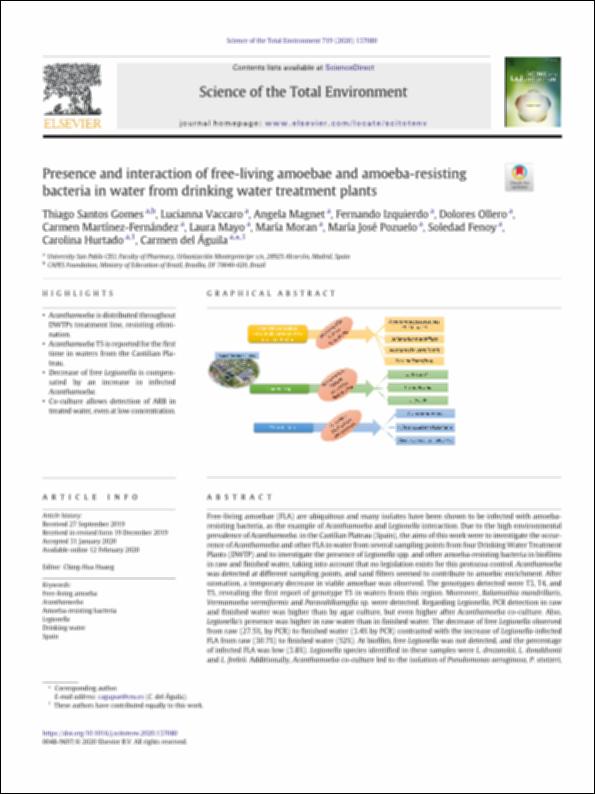Por favor, use este identificador para citar o enlazar este ítem:
http://hdl.handle.net/10637/15035Presence and interaction of free-living amoebae and amoeba-resisting bacteria in water from drinking water treatment plants
| Título : | Presence and interaction of free-living amoebae and amoeba-resisting bacteria in water from drinking water treatment plants |
| Autor : | Gomes, Thiago Santos Vaccaro Muñoz, Lucianna Rosalía Magnet, Angela Izquierdo Arias, Fernando Ollero Baceiredo, Dolores Martínez-Fernández, Carmen Mayo Martinez, Laura Moran Garrido, María Pozuelo de Felipe, María José Fenoy Rodríguez, Soledad Hurtado Marcos, Carolina Águila de la Puente, Carmen del |
| Materias: | Acanthamoeba; Amoeba-resisting bacteria; Drinking water; Free-living amoeba; Legionella; Spain |
| Editorial : | Elsevier |
| Citación : | Gomes TS, Vaccaro L, Magnet A, Izquierdo F, Ollero D, Martínez-Fernández C, Mayo L, Moran M, Pozuelo MJ, Fenoy S, Hurtado C, Del Águila C. Presence and interaction of free-living amoebae and amoeba-resisting bacteria in water from drinking water treatment plants. Sci Total Environ. 2020 Jun 1;719:137080. doi: 10.1016/j.scitotenv.2020.137080. |
| Resumen : | Free-living amoebae (FLA) are ubiquitous and many isolates have been shown to be infected with amoeba-resisting bacteria, as the example of Acanthamoeba and Legionella interaction. Due to the high environmental prevalence of Acanthamoeba. in the Castilian Plateau (Spain), the aims of this work were to investigate the occurrence of Acanthamoeba and other FLA in water from several sampling points from four Drinking Water Treatment Plants (DWTP) and to investigate the presence of Legionella spp. and other amoeba-resisting bacteria in biofilms in raw and finished water, taking into account that no legislation exists for this protozoa control. Acanthamoeba was detected at different sampling points, and sand filters seemed to contribute to amoebic enrichment. After ozonation, a temporary decrease in viable amoebae was observed. The genotypes detected were T3, T4, and T5, revealing the first report of genotype T5 in waters from this region. Moreover, Balamuthia mandrillaris, Vermamoeba vermiformis and Paravahlkampfia sp. were detected. Regarding Legionella, PCR detection in raw and finished water was higher than by agar culture, but even higher after Acanthamoeba co-culture. Also, Legionella's presence was higher in raw water than in finished water. The decrease of free Legionella observed from raw (27.5%, by PCR) to finished water (3.4% by PCR) contrasted with the increase of Legionella-infected FLA from raw (30.7%) to finished water (52%). At biofilm, free Legionella was not detected, and the percentage of infected FLA was low (3.8%). Legionella species identified in these samples were L. drozanskii, L. donaldsonii and L. feeleii. Additionally, Acanthamoeba co-culture led to the isolation of Pseudomonas aeruginosa, P. stutzeri, P. fluorecens, Achromobacter xylosoxidans and Stenotrophomonas maltophilia. The highly disseminated presence of Acanthamoeba and the detection of amoeba-resisting bacteria inside amoebae highlight the importance of developing methods for controlling FLA in order to limit human pathogenic amoeba-resisting bacteria survival to the water purification processes. |
| Descripción : | Acceso al texto completo en la siguiente URL: https://www.sciencedirect.com/science/article/pii/S0048969720305908 Este artículo está en acceso abierto siguiendo la política de la revista |
| URI : | http://hdl.handle.net/10637/15035 |
| ISSN : | 0048-9697 |
| Fecha de publicación : | 12-feb-2020 |
| Centro : | Universidad San Pablo-CEU |
| Aparece en las colecciones: | Facultad de Farmacia |
Los ítems de DSpace están protegidos por copyright, con todos los derechos reservados, a menos que se indique lo contrario.


